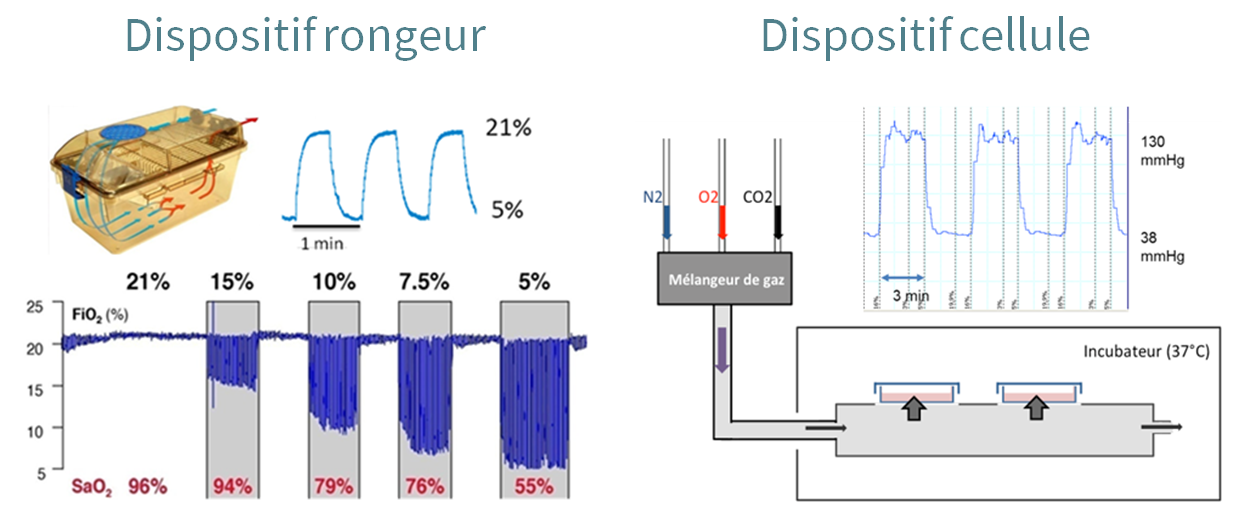- Share
- Share on Facebook
- Share on X
- Share on LinkedIn
HP2's Basic Science team, managed by Pr. Diane GODIN-RIBUOT, is performed on the Health Site at Jean Roget building, 6th floor, near the Michallon Hospital (hosting the lab's clinical research). The team brings together researchers, lecturers-researchers (mostly from Pharmacology and Biology teaching units), post-doctorants, PhD students and other students from various university streams.

Background
The Obstructive Sleep Apnea Syndrome (OSAS) is one of the more common chronic respiratory disorder and its worldwide prevalence won't stop increasing. OSAS represent a real public health issue with this high prevalence, patients life quality alteration, and mostly because it is accepted as an independant metabolic and cardiovascular risk factor.
Today's reference treatment remains the continuous positive airway pressure (CPAP) use during the sleep, nasally delivered. This method keeps the upper airways, removes apneas and normalizes the sleep. CPAP represents an improvement for the life quality, neurocognitive functions, and cardiovascular risks prevention. Nevertheless, CPAP unwillingness and waiver rates are large and CPAP does not improve all OSAS-linked complications.
Intermittent hypoxia, HP2's basic science research mainstay
OSAS generates a sleep fragmentation (caused by apnea-linked micro-awakenings), intra-thoracic pressure variations (directly linked to apnea), and oxygen re-establishment desaturation short, fast and repeated cycles typifying intermittent hypoxia. This intermittent hypoxia is the OSAS principal consequence in terms of metabolic and cardiovascular complications.
Hence, the team's first research axis relates to the understanding of intermittent hypoxia-linked physiopathological mechanisms liable for OSAS complications. More specifically, the team's activities focus on intermittent hypoxia impacts on :
- The heart: heart failure development, myocardial ischemia-reperfusion responses,
- The vessels: atherosclerosis development, vascular remodeling and mechanics, hypertension development,
- The Metabolism: glucose homeostatic alterations, insulin resistance development, adipose tissue remodeling, hepatic steatosis (NASH)
- The Cancer: metastatic and tumor development
The team also studies intermittent hypoxia consequences on other organs such as the kidney, the brain or even the eye. The consequences are also studied in association with other co-morbidities likely to modulate the hypoxia response, such as ageing, obesity, or nutrition.
Research mainstreaming
By the use of experimental models, various physiological, biochemical, pharmacological investigation techniques, the team builds numerous projects aiming to understand the intermittent hypoxia impacts on the body.
These studies are performed in the perspective of a OSAS pathology and its complications better understanding, exploring clear intracellular mechanisms.
The results produced by this team represent a great support for the clinical research. In fact, they contribute to the identification of new potential therapeutic methods. They also contribute to the proposal of new pharmacological or interventional (exercise, nutrition) approaches as an alternative to the current referent SAS treatment that can be constraining with limited efficiency.
Specific tools development
In order to complete the objectives, the Basic Science team uses various physiological approaches (echography, IRM, in vivo chirurgical methods, etc.) and developed, in collaboration with, a competitive intermittent hypoxia exposure device, unique in Europe, performing hypoxia exposure on rodents and cells (read more about the HypE technical core).

- Share
- Share on Facebook
- Share on X
- Share on LinkedIn